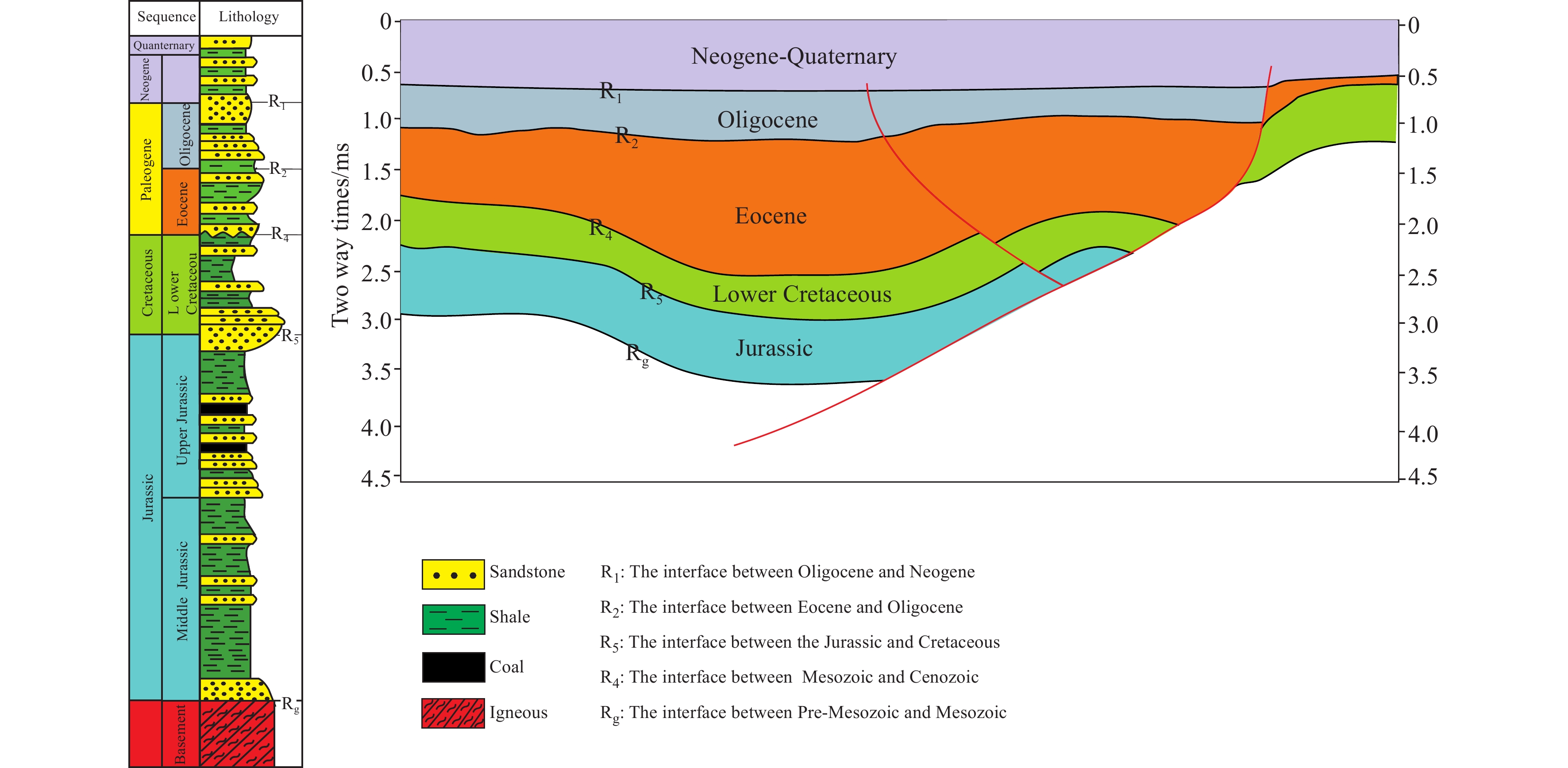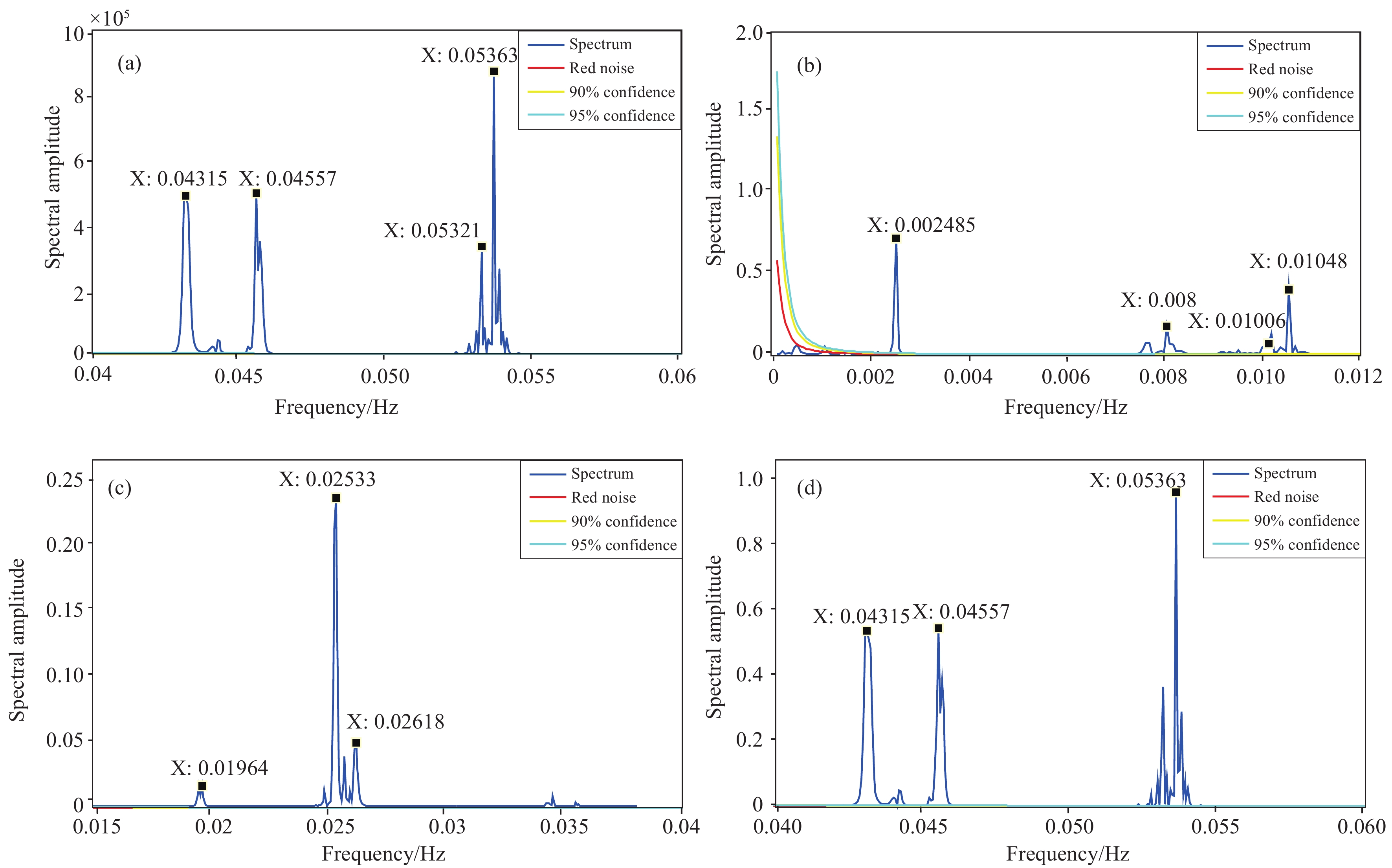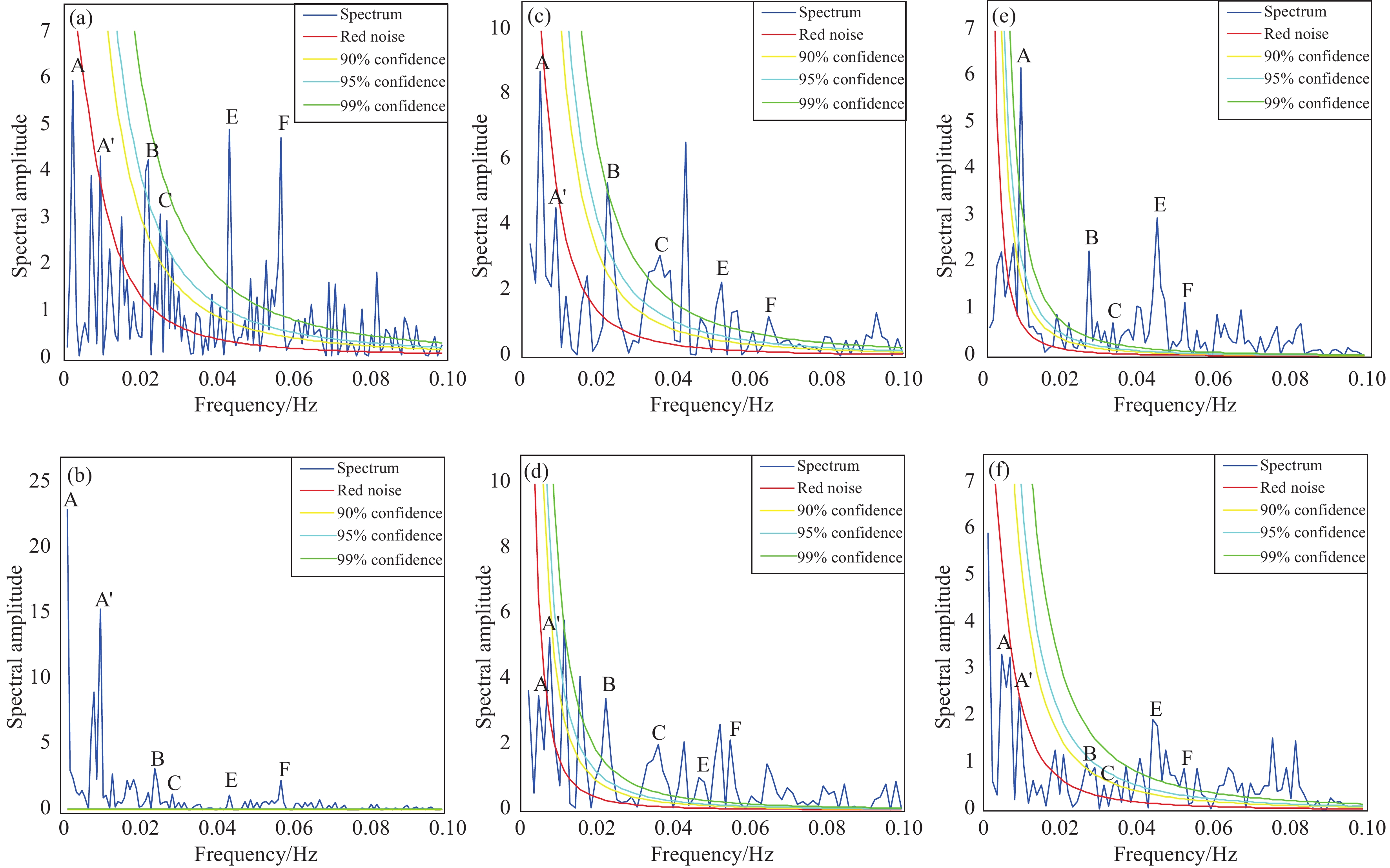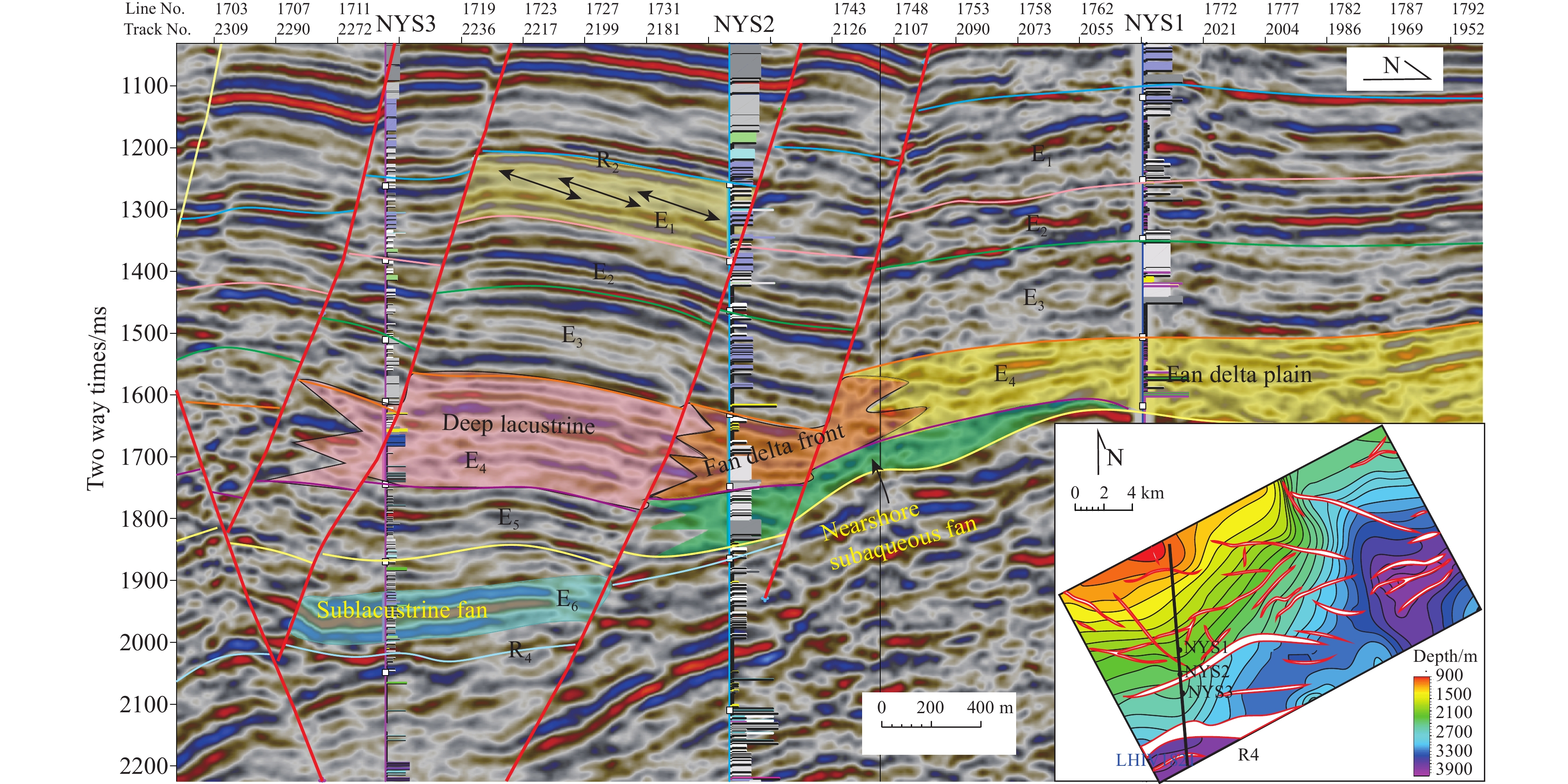| Citation: | Shu-yu Wu, Jun Liu, Jian-wen Chen, Hao-ran Wu, 2021. Characteristics of Milankovitch cycles recorded in Eocene strata in the eastern depression of North Yellow Sea Basin, North China, China Geology, 4, 274-287. doi: 10.31035/cg2021002 |
Characteristics of Milankovitch cycles recorded in Eocene strata in the eastern depression of North Yellow Sea Basin, North China
-
Abstract
As cyclical orbital movements of Earth, Milankovitch cycles can be recorded in sedimentary strata. The time they reflect can be used to accurately divide and compare strata. Milankovitch cycles recorded in strata enrich the stratigraphic theory, especially the theories of cycle stratigraphy, and thus they are widely used in geological survey engineering nowadays. This study explored the characteristics of the Milankovitch cycles recorded in the eastern depression of the North Yellow Sea Basin, highlighting their control over high-frequency stratigraphic sequences. The Eocene Milankovitch cycles in the depression were calculated based on the method proposed by J. Laskar, and their parameters primarily include eccentricity cycles of 125 ka and 99 ka, obliquity cycles of 51 ka and 39 ka, and precession cycles of 23 ka and 19 ka. Spectral analysis of gamma-ray (GR) and spontaneous potential (SP) log curves of the Eocene strata was carried out to divide and compare stratigraphic sequences, revealing that the spectral peaks correspond well to astronomical cycles. This indicates that the strata in the depression fully record Milankovitch cycles. Furthermore, there are long-, medium-, and short-term stratigraphic cycles in the eastern depression, with a thickness of 13.03–15.89 m, 3.70–5.21 m, and 2.17–2.94 m, respectively. The sedimentation rates of the Eocene strata were calculated to be 121.2–127.12 m/Ma accordingly. From the uplift to the center of the lacustrine basin along the slope in the eastern depression, both the sedimentation duration and the sediment thickness increase, while the sedimentation rate remains relatively stable. The Eocene strata can be divided into six stages of high-frequency sequences by continuous wavelet transformation, namely E6–E1 from bottom to top. The sedimentation duration and sedimentation rates of the sequences were calculated using spectral analysis with each of the sequences as a separate window. Moreover, the impacts of climate change on the sedimentary environment in the eastern depression were analyzed. It can be concluded that E6 was a lowstand system tract, E5 and E4 were lacustrine expansion system tracts, E3 was a highstand system tract, and E2 and E1 were lacustrine contraction system tracts. All these verify that Milankovitch cycles serve as an effective approach for the analysis of sedimentary cycles.
-

-
References
Bailey RJ. 2001. Sequence stratigraphy and orbital forcing in Permian (Rotliegend) desert deposits: A discussion. Journal of the Geological Society, 158(5), 785–791. doi: 10.1144/jgs.158.5.785. Berger WH. 2013. Milankovitch tuning of deep-sea records: Implications for maximum rates of change of sea level. Global and Planetary Change, 101, 131–143. doi: 10.1016/j.gloplacha.2012.10.013. Brescia M, D’Argenio B, Ferreri V, Longo G, Pelosi N, Rampone S, Tagliaferri R. 1996. Neural net aided detection of astronomical periodicities in geologic records. Earth and Planetary Science Letters, 139(1−2), 33–45. doi: 10.1016/0012-821X(96)84608-5. Cai QZ. 2002. Regional geology and geotectonic environment of petroliferous basins in the Yellow Sea. Marine Geology Letters, 18(11), 8–12 (in Chinese with English abstract). Cao D, Wang XG, Zhan WF, Li WY. 2007. Subsidence history of the eastern depression in the North Yellow Sea Basin. Journal of China University of Mining and Technology, 17(1), 90–95. doi: 10.1016/S1006-1266(07)60020-0. Chen L, Liu ZH, Jin QH, Wang YM, Yuan SK. 2008. Meso‒Cenozoic tectonic evolution of the east Depression of North Yellow Sea. Geotectonica et Metallogenia, 32(3), 308–316 (in Chinese with English abstract). Deino AL, Kingston JD, Glen JM, Edgar RK, Hill A. 2006. Precessional forcing of lacustrine sedimentation in the late Cenozoic Chemeron Basin, Central Kenya rift, and calibration of the Gauss/Matuyama boundary. Earth and Planetary Science Letters, 247(1−2), 41–60. doi: 10.1016/j.jpgl.2006.04.009. Dobrovolskis AR. 2013. Insolation on exoplanets with eccentricity and obliquity. Icarus, 226(1), 760–776. doi: 10.1016/j.icarus.2013.06.026. Elderbak K, Leckie RM, Tibert NE. 2014. Paleoenvironmental and paleoceanographic changes across the Cenomanian-Turonian Boundary Event (Oceanic Anoxic Event 2) as indicated by foraminiferal assemblages from the eastern margin of the Cretaceous Western Interior Sea. Palaeogeography, Palaeoclimatology, Palaeoecology, 413, 29–48. doi: 10.1016/j.palaeo.2014.07.002. Eriksson PG, Banerjee S, Catuneanu O, Corcoran PL, Eriksson KA, Hiatt EE, Laflamme M, Lenhardt N, Long DGF, Miall AD, Mints MV, Pufahl PK, Sarkar S, L Simpson E, Williams GE. 2013. Secular changes in sedimentation systems and sequence stratigraphy. Gondwana Research, 24(2), 468–489. doi: 10.1016/j.gr.2012.09.008. Feng ZQ, Yao YJ, Zeng XH. 2002. New understanding of Mesozic-Paleozoic tectonics and hydrocarbon potential in Yellow Sea. China offshore oil and gas (Geology), 16, 367–373 (in Chinese with English abstract). Gong CL, Lei HY, Wang YM, Liu ZH, Guan BC, Hu XQ, Lu JB. 2009. Hydrocarbon geologic characters and structural evolution in the eastern depression of North Yellow Sea Basin. Marine Geology and Quaternary Geology, 29(1), 79–86 (in Chinese with English abstract). Guo HX, Sun DY, Gou J, Wu PF, Wang TH, Guo HY, Liu XM. 2015. Chronology, geochemistry and Hf isotope of granite from southern Xingkai Block. Earth Science-Journal of China University of Geosciences, 40(6), 982–994 (in Chinese with English abstract). doi: 10.3799/dqkx.2015.082. Hays JD, Imbrie J, Shackleton NJ. 1976. Variations in the Earth’s orbit: Pacemaker of the ice ages. Science, 194(4270), 1121–1132. doi: 10.1126/science.194.4270.1121. Hinnov LA. 2013. Cyclostratigraphy and its revolutionizing applications in the earthand planetary sciences. Geological Society of America Bulletin, 125, 1703–1734. doi: 10.1130/B30934.1. Hinnov LA, Hilgen FJ. 2012. Chapter 4: Cyclostratigraphy and astrochronology, in: Gradstein FM, Ogg JG, Smith MD, Ogg GM (eds.). A Geologic Time Scale 2012: Amsterdam, Elsevier, 63–83. Ji YL, 2005. Sequence Stratigraphy. Shanghai, Tongji University Press, 157 (in Chinese). Killops SD, Howell VJ. 1991b. Complex series of pentacyclic triterpanes in a lacustrine sourced oil from Korea Bay Basin. Chemical Geology, 91(1), 65–79. doi: 10.1016/0009-2541(91)90016-K. Killops SD, Massoud MS, Scott AC. 1991a. Biomarker characterisation of an oil and its possible source rock from offshore Korea bay basin. Applied Geochemistry, 6(2), 143–157. doi: 10.1016/0883-2927(91)90025-K. Kim IS, Fei Q, Yang XH, Cai F. 2006. The Petroleum system and exploration prospect in the east of North Yellow Sea Basin. Petroleum Geology and Experiment, 28(5), 445–449, 457 (in Chinese with English abstract). Lapierre H, Jahn BM, Charvet J. 1997. Mesozoic felsic arc magmatism and continental olivine tholeiites in Zhejiang Province and their relationship with tectonic activity in SE-China. Tectonophysics, 274, 321–338. doi: 10.1016/S0040-1951(97)00009-7. Laskar J, Fienga A, Gastineau M, Manche H. 2011. La2010: A new orbital solution for the long-term motion of the Earth. Astronomy & Astrophysics, 532(A89), 1–15. doi: 10.1051/0004-6361/201116836. Laurin J, Barclay RS, Sageman BB, Dawson RR, Schmitz M, Eaton J, Mcinerney FA, Mcelwain JC. 2019. Terrestrial and marginal-marine record of the mid-Cretaceous Oceanic Anoxic Event 2 (OAE 2): High-resolution framework, carbon isotopes, CO2 and sea-level change. Palaeogeography, Palaeoclimatology, Palaeoecology, 524, 118–136. doi: 10.1016/j.palaeo.2019.03.019. Laya JC, Tucker ME, Perez-Huerta A. 2013. Metre-scale cyclicity in permian ramp carbonates of equatorial pangea (venezuelan andes): Implications for sedimentation under tropical pangea conditions. Sedimentary Geology, 292, 15–35. doi: 10.1016/j.sedgeo.2013.04.002. Lever H. 2004. Cyclic sedimentation in the shallow marine Upper Permian Kennedy Group, Carnarvon Basin, Western Australia. Sedimentary Geology, 172(1−2), 187–209. doi: 10.1016/S1342-937X(05)70312-9. Li HC, Bischoff JL, Ku TL, Zhu ZY. 2004. Climate and hydrology of the last Interglaciation (MIS 5) in Owens Basin, California: Isotopic and geochemical evidence from core OL-92. Quaternary Science Reviews, 23(1–2), 49–63. doi: 10.1016/S0277-3791(03)00215-4. Li MS, Zhang Y, Huang CJ, Ogg J, Hinnov L, Wang YD, Zou ZY, Li LQ. 2017. Astronomical tuning and magnetostratigraphy of the Upper Triassic Xujiahe Formation of South China and Newark Supergroup of North America: Implications for the Late Triassic time scale. Earth and Planetary Science Letters, 475, 207–223. doi: 10.1016/j.jpgl.2017.07.015. Li NS. 1995. Tectonic evolution of three structural basin in the Yellow Sea. Oceanologia et Limnologia Sinica, 26, 354–362 (in Chinese with English abstract). Li QM. 1996. The analysis and application of Milankovitch Cycles by logging data. Acta Geophysica Sinica, 39(5), 699–704 (in Chinese with English abstract). Liang J, Wen ZH, Xiao GL, Zhang YG, Dong HP. 2013. Reservoir characteristics and influential factors in the eastern depression of the North Yellow Sea Basin. Marine Geology & Quaternary Geology, 33(2), 111–119 (in Chinese with English abstract). Lin CS, Zhang YM, Li ST, Ren JY, Zhang YZ. 2004. Episodic rifting dynamic process and quantitative model of Mesozoic Cenozoic faulted basin. AAPG Bull, 60, 554–566. doi: 10.1016/S0960-0779(03)00420-X. Liu JP, Wang LL, Jian XL, Du M, Wang GY. 2015. Analyzing geochemical characteristics and hydrocarbon generation history of the Middle and Upper Jurassic source rocks in the North Yellow Sea Basin. Journal of Petroleum Science and Engineering, 126, 141–151. doi: 10.1016/j.petrol.2014.10.003. Liu T, Broecker WS. 2013. Millennial-scale varnish microlamination dating of late Pleistocene geomorphic features in the drylands of Western USA. Geomorphology, 187, 38–60. doi: 10.1016/j.geomorph.2012.12.034. Marra F, Florindo F. 2014. The subsurface geology of Rome: Sedimentary processes, sea-level changes and astronomical forcing. Earth-Science Reviews, 136, 1–20. doi: 10.1016/j.earscirev.2014.05.001. Maselli V, Trincardi F, Asioli A, Ceregato A, Rizzetto F, Taviani M. 2014. Delta growth and river valleys: The influence of climate and sea level changes on the South Adriatic Shelf (Mediterranean Sea). Quaternary Science Reviews, 99, 146–163. doi: 10.1016/j.quascirev.2014.06.014. Massoud MS, Scott AC, Killops SD, Mattey ML. 1993. Oil source rock potential of the lacustrine Jurassic SIM UUJU Formation, West Korea Bay Basin part II: Nature of the organic matter and hydrocarbon-generation history. Journal of Petroleum Geology, 16(3), 265–284. doi: 10.1111/j.1747-5457.1993.tb00338.x. Meyers SR. 2019. Cyclostratigraphy and the problem of astrochronologic testing. Earth-Science Reviews, 190, 190–223. doi: 10.1016/j.earscirev.2018.11.015. Moore GW. 1990. Mesozoic-Cenozoic paleogeography of the Circum-Pacific Region. Terrane analysis of China and the Pacific Rim, vol. 13. Circum-Pacific council for energy and mineral Resources Earth Science Series. Houston, Texas, 71‒73. Poletti L, Premoli S, Silva IP, Masetti D, Pipanc M, Claps M. 2004. Orbitally driven fertility cycles in the palaeocene pelagic sequences of the Southern Alps (Northern Italy). Sedimentary Geology, 164(1−2), 35–54. doi: 10.1016/j.sedgeo.2003.09.001. Qiao PJ, Zhu WL, Shao L, Zhang DJ, Cheng XR, Song YM. 2015. Carbonate stable isotope stratigraphy of Well Xike-1, Xisha Islands. Earth Science-Journal of China University of Geosciences, 10(4), 725–732 (in Chinese with English abstract). doi: 10.3799/dqkx.2015.060. Tian SF. 2012. Cyclostratigraphy of Mesozoic and Cenozoic and implication for hydrocarbon exploration-case study of the Huizhou Depression and Meishan Section (Dissertation). Qingdao, China University of petroleum (Eastern China), doctoral thesis, 1, (in Chinese with English abstract). Tian ZX, Zhang XH, Xue RJ. 2004. Regional geologic features of the North Yellow Sea Basin. Marine Geology Frontiers, 20(2), 8–10 (in Chinese with English abstract). Wang LF, Wang YT, Hu XQ. 2010. Stratigraphy and sedimentary characters of the western depression, North Yellow Sea Basin. Marine Geology & Quaternary Geology, 30(3), 97–104 (in Chinese with English abstract). doi: 10.3724/SP.J.1140.2010.03097. Wang R, Wang LL, Shi WZ, Xie XY, Manger W, B Busbey A, Xu Q. 2017a. Lower Cretaceous lacustrine successions, North Yellow Sea Basin, eastern China: Rift basin sequence stratigraphy and stacking patterns in response to magmatic activity. Marine and Petroleum Geology, 88, 531–550. doi: 10.1016/j.marpetgeo.2017.09.006. Wang R, Shi WZ, Xie XY, Wang LL, B Busbey A, Manger W, Xia ZM. 2017b. Hydrothermal indications of Early Cretaceous red beds in lacustrine successions, North Yellow Sea Basin, Eastern China. Marine and Petroleum Geology, 88, 739–755. doi: 10.1016/j. marpetgeo.2017.09.016. Wang YJ, Guo ZQ, Liu WH, Xu XL, Zeng FY. 2007. Analysis of Milankovitch Cycles of Quaternary in Sanhu Area, Eastern Qaidam Basin. Progress in Geophysics, 22(2), 544–551 (in Chinese with English abstract). doi: 10.1007/s11442-007-0020-2. Wu SY, Liu J. 2015. High resolution sequence stratigraphic study basic on time-frequency analysis. Marine Geology and Quaternary Geology, 35(4), 197–207. Yang YQ, Qiu LW, Yu KH. 2016. Origin and reservoirs characterization of lacustrine carbonate in the Eocene Dongying Depression, Bohai Bay Basin, East China. Geological Journal, 52, 808–827. doi: 10.1002/gj.2848. Yuan X, Guo Y, Yu J, Shen YL, Shao YB. 2013. Correlation and analysis of well-log sequence with Milankovitch cycles as rulers: A case study of coal-bearing strata of Late Permian in Western Guizhou. International Journal of Mining Science and Technology, 23(4), 563–568. doi: 10.1016/j.ijmst.2013.07.015. Zhang L, Zhou YZ, Wang LL, Li WY, Li GY. 2009. A Study on hydrocarbon generation conditions in the North Yellow Sea Basin. Natural Gas Industry, 29(1), 21–25 (in Chinese with English abstract). doi: 10.3787/j.issn.1000-0976.2009.01.005. Zhang R, Jin Z, Liu Q, Li P, Huang Z, Shi J, Ge Y, Du K. 2019. Astronomical constraints on deposition of the Middle Triassic Chang 7 lacustrine shales in the Ordos Basin, Central China. Palaeogeography, Palaeoclimatology, Palaeoecology, 528, 87–98. doi: 10.1016/j.palaeo.2019.04.030. Zhang Z, Cheng RH, Shen YJ, Wang LL, Hu XQ. 2018. Mesozoic sequence stratigraphy and its response to tectonic evolution of the Eastern Depression, North Yellow Sea Basin, North China. Journal of Asian Earth Sciences, 160, 445–459. doi: 10.1016/j.jseaes.2017.08.001. Zhang ZS, Cai DG, Gang LD. 1999. Studying sedimentation rate by means of spectral analysis of logs. Journal of Jianghan Petroleum Institute, 21(4), 18–20 (in Chinese with English abstract). Zhao ZJ, Chen X, Pan M, Wu XN, Zheng XP, Pan WQ. 2010. Milankovitch cycles in the upper Ordovician Hanglitage formation in the Tazhong-Bachu area, Tarim basin. Acta Geologica Sinica, 84(4), 518–536. Zhu G, Wang DX, Liu GS, Niu ML, Song CZ. 2004. Evolution of the Tan-Lu fault zone and its responses to plate movements in West Pacific Basin. Chinese Journal of Geology (Scientia Geologica Sinica), 39(1), 36–49 (in Chinese with English abstract). doi: 10.1007/BF02873097. -
Access History

-
Figure 1.
Tectonic map of the NYSB (a) and schematic map of the structural units in the NYSB (b) (modified from Liang J et al., 2013). NYSB‒North Yellow Sea Basin.
-
Figure 2.
Comprehensive histogram and geological section of the eastern depression of the NYSB.
-
Figure 3.
Spectrograms of insolation, eccentricity, obliquity, and precession during 36.5‒53 Ma. a‒spectrum of Eocene insolation; b‒spectrum of Eocene eccentricity; c‒spectrum of Eocene obliquity; d‒spectrum of Eocene precession.
-
Figure 4.
Spectrograms of GR and SP log curves of Eocene strata at wells NYS3, NYS2, and NYS1. a‒spectrogram of GR log curve at Well NYS3; b‒spectrogram of SP log curve at Well NYS3; c‒spectrogram of GR log curve spectral analysis at Well NYS2; d‒spectrogram of SP log curve of Eocene strata at Well NYS2; e‒spectrogram of GR log curve at Well NYS1; f‒spectrogram of SP log curve at Well NYS1.
-
Figure 5.
Stratigraphic correlation of Eocene strata in the eastern depression of NYSB revealed by wells.
-
Figure 6.
Seismic reflection characteristics of Eocene strata in the eastern depression of NYSB. R2‒interface between Eocene and Oligocene strata; R4‒ interface between Mesozoic and Cenozoic strata; E6−E1‒Eocene sequences from bottom to top.

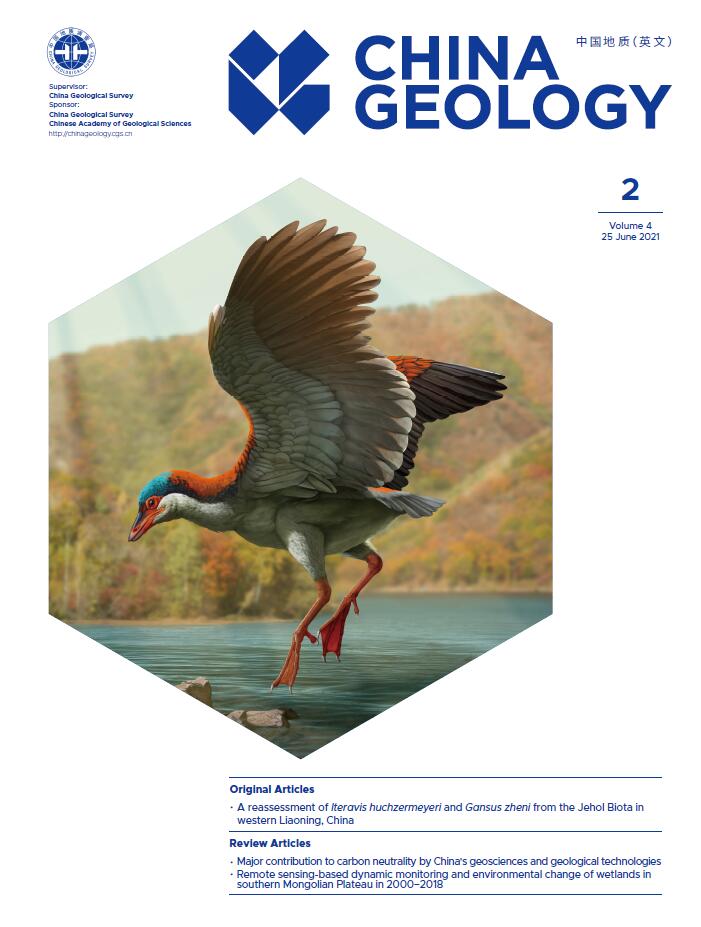

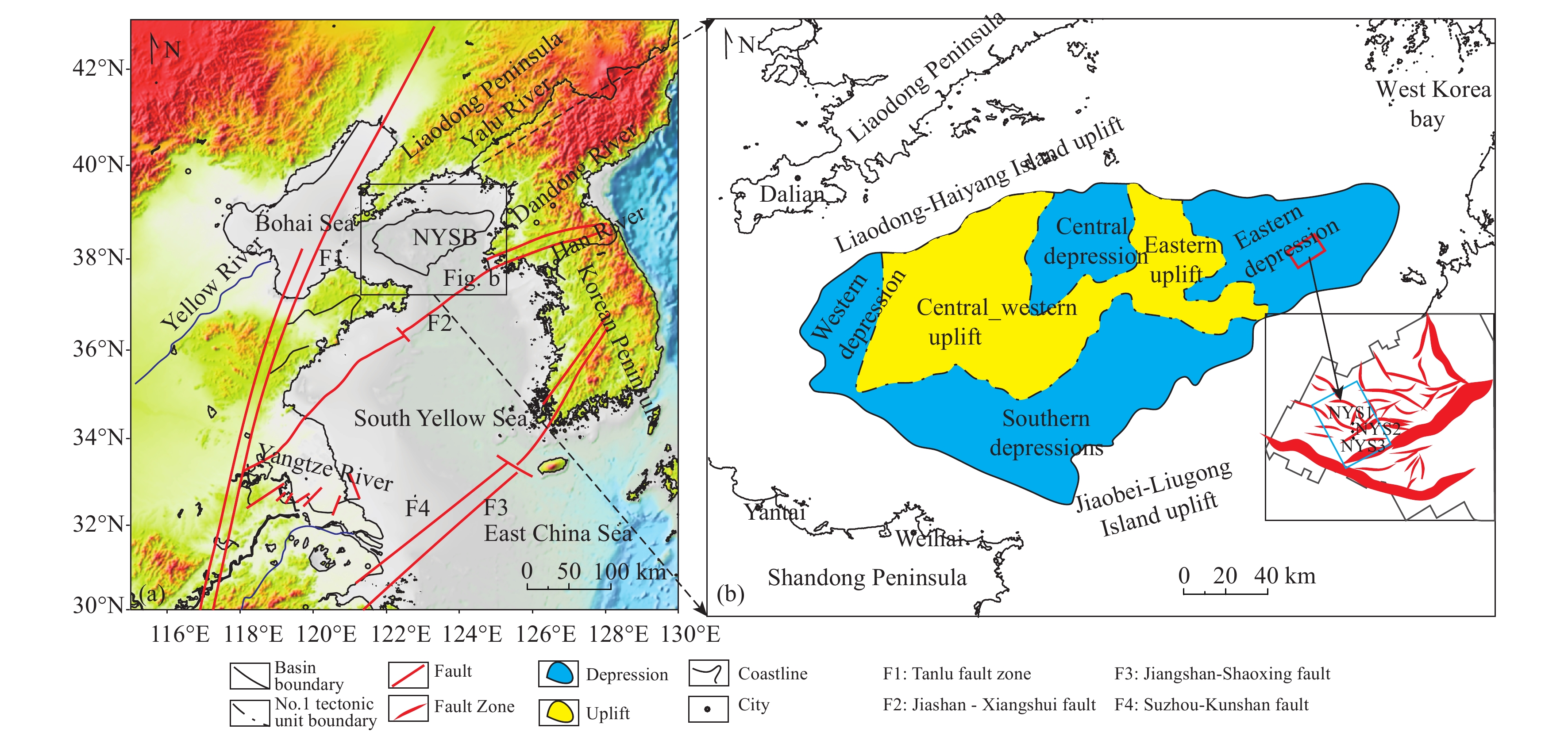

 DownLoad:
DownLoad:
